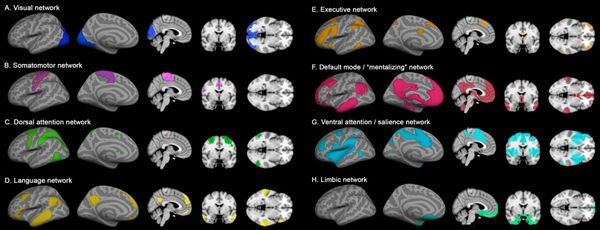Intrinsic networks
Chapter 4 endnote 5, from How Emotions are Made: The Secret Life of the Brain by Lisa Feldman Barrett.
Some context is:
Intrinsic networks are considered one of neuroscience’s great discoveries of the past decade.

An intrinsic brain network is a population of neurons that fire synchronously (in the same pattern) so that their firing is strongly related over time.[1][2] The neurons that make up an intrinsic network coordinate their spontaneous activity via their anatomical connections (i.e., they synapse on one another). The structural connections between neurons (i.e., synpases) do not determine an intrinsic network, but place boundaries on or “constrains” those networks (whose connectivity is functional).[3][4] Within these constraints, the intrinsic networks are more variable and have a dynamic, functional repertoire.[5]
Sensory input does not impose its own new firing pattern in the brain; instead, it modulates or tunes the pattern that is already present.[6] The brain has a vocabulary or repertoire of dynamic states that can occur during intrinsic activity; these are "sampled" by incoming sensory input.[4]
Intrinsic networks are easy to find using fMRI. Simply scan someone whose mind is wandering or who is keeping a clear mind—not thinking, feeling or doing anything at all—and search for sets of voxels that show a coordinated pattern of activity. These voxels reveal an intrinsic brain network.
Hundreds of experiments have demonstrated that the human brain contains intrinsic networks. These networks have been seen in thousands of people within the same culture, and in people from different cultures. They can be seen when people are asleep or under anesthesia (showing that their existence really does not depend on stimulation from the outside world). These networks develop in the first few years of life. Some of them are unique to humans, whereas others can be seen in the brains of other apes, and monkeys, and even in rats, although they may not perform the same function in humans and non-human animals.
The English neurophysiologist Thomas Graham Brown, a student of Charles Scott Sherrington, offered observations about intrinsic neural activity a century ago, well before these networks were discovered.[7]
Notes on the Notes
- ↑ There are many, many scientific articles on intrinsic networks. For example, Cole, Michael W., Danielle S. Bassett, Jonathan D. Power, Todd S. Braver, and Steven E. Petersen. 2014. "Intrinsic and task-evoked network architectures of the human brain." Neuron 83 (1): 238-251.
- ↑ Another example: Yeo, BT Thomas, Fenna M. Krienen, Jorge Sepulcre, Mert R. Sabuncu, Danial Lashkari, Marisa Hollinshead, Joshua L. Roffman et al. 2011. "The organization of the human cerebral cortex estimated by intrinsic functional connectivity." Journal of Neurophysiology 106 (3): 1125-1165.
- ↑ For example, Deco, Gustavo, Viktor K. Jirsa, and Anthony R. McIntosh. 2011. "Emerging concepts for the dynamical organization of resting-state activity in the brain." Nature Reviews Neuroscience 12 (1): 43-56.
- ↑ 4.0 4.1 Sporns, Olaf. 2011. Networks of the Brain. Cambridge, MA: MIT Press.
- ↑ Sporns, Olaf. 2014. "Contributions and challenges for network models in cognitive neuroscience." Nature Neuroscience 17 (5): 652-660.
- ↑ MacLean, Jason N., Brendon O. Watson, Gloster B. Aaron, and Rafael Yuste. 2005. "Internal dynamics determine the cortical response to thalamic stimulation." Neuron 48 (5): 811-823.
- ↑ Brown, T. Graham. 1914. "On the nature of the fundamental activity of the nervous centres; together with an analysis of the conditioning of rhythmic activity in progression, and a theory of the evolution of function in the nervous system." The Journal of Physiology 48 (1): 18-46.